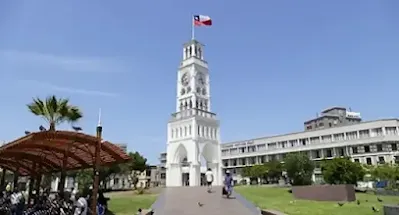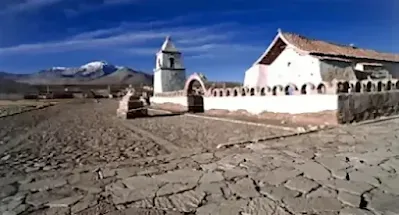- Get link
- Other Apps
 |
| Wikimedia Commons, by Freddy Alexander Bugueño Tolmo |
The modern capital of the Tarapaca Region has had a rapid growth in the last decades, thanks to mining, other industrial activities and the existence of the Free Trade Zone known as ZOFRI, the city has also a great patrimonial and historical value, reflected in many details that can be appreciated by walking its streets and surroundings. Currently, the population is a little more than 220,000 inhabitants. In this regard, in recent decades Chile has received large groups of immigrants of Latin American origin, and the north of the country is no exception.
Below is a list of the most popular tourist places in Iquique, also known among the Chileans as "Tierra de Campeones" (Land of Champions), since the city has been the birthplace of many great athletes.
Torre del Reloj (Clock Tower)
 |
| Image: Vilas Radio 100.1 FM - Iquique |
Erected by order of the Peruvian Government, (since in those years Iquique was a Peruvian city), it is a National Historic Monument that constitutes one of the most representative urban expressions of the "nitrate era", built in Oregon pine, material impossible to find in a region surrounded by the Atacama Desert. The Chilean-French engineer Eduardo Lapeyrouse, had ordered the design of the tower and the clock to Europe in 1877, Lapeyrouse was later the first Mayor of Iquique when the city became Chilean in 1879. In 1884, it was located in the center of Plaza Prat, where it remains to this day.
Museo Corbeta Esmeralda (Corbeta Esmeralda Ship- Museum)
 |
| Image: Tarapaca Insitu Online |
The museum was inaugurated in 2011 and provides an opportunity to learn about Chile's history. Surprising realism is achieved by considering every detail. The original plans were requested from England, and an investigation was conducted on the sunken ship to ensure the museum is as accurate as possible. The sound of the sea can be heard in every corner, creating the illusion that the ship is moving, although it is actually on land.
Paseo Baquedano (Baquedano Promenade)
The pedestrian promenade is lined with luxurious old mansions from the golden decades of Chilean saltpeter production in the late 19th and early 20th centuries. It has been a National Monument of Chile since 1977, categorized as a Typical Zone. Today, it is one of the most emblematic and historic areas of the city. Paseo Baquedano is a must-see tourist circuit. The buildings appear to have remained in the past when the train from the 'Oficinas Salitreras' ran along this route.
Teatro Municipal de Iquique (Municipal Theater)
The Teatro Municipal is a refined building located in front of the Plaza de Armas. It was built in 1889 and formally inaugurated on January 1, 1890. The building was constructed during the economic boom of the saltpeter industry (1880-1930) and is almost entirely made of Oregon Pine imported from the United States. Its central location makes it easily accessible. The Municipal Theater restoration is well underway and the remodeled building is expected to be completed in 2024.
Museo Regional de Iquique (Regional Museum)
The museum is located at 951 Paseo Baquedano, on the ground floor of a building that was constructed in 1892. It was founded in 1960 under the patronage of the Universidad del Norte and has been run by the Corporacion Municipal de Desarrollo Social de Iquique since 1982. Originally, the building housed the first 'Intendencia de Tarapaca' and then the Court of Justice.
The museum has three areas: anthropological, ethnographic, and historical. The museum offers insights into the regional past dating back 10,000 years. It covers the Chinchorro and Aymara communities, as well as other cultures that influenced the current North of Chile. Additionally, visitors can learn about the Tiwanaku (Tiahuanaco) and Inca cultures. The ethnographic section showcases the way of life of the Aymaras from their origins to the present day. The historical exhibit covers the Nitrate era from beginning to end.
The "ZOFRI" (Iquique's Free Trade Zone)
The ZOFRI is the largest commercial center in northern Chile and one of the most important in South America. It has become a must-visit for tourists, even though it was not initially intended as a tourist attraction. It promotes an important commercial exchange with neighboring countries such as Argentina, Bolivia, Peru, Paraguay, and Brazil. Consider spending at least one day visiting the ZOFRI Mall and facilities.
Beaches of Iquique
Playa Cavancha is the most popular and central beach in the city, located near the old quarter. It is surrounded by a modern urban architecture, the seashore, and a walking area. It covers a considerable length and has good conditions for outdoor and sport activities, like surfing and swimming.
Due to the influence of the Humboldt Current, the coasts of Chile are generally colder than those of the Atlantic. However, in Cavancha, the sea is warm, and visitors can swim year-round. The beach is extensive and offers various forms of entertainment. The northern sector of the beach is characterized by intense waves, making it suitable for water skiing, sailing, surfing, windsurfing, and bodyboarding.
Playa Brava, located 4 km south of downtown in a highly developed area of the city, is situated to the south. Playa Huayquique is not suitable for swimming due to its strong swell. However, it is an excellent spot for sport fishing, water sports, sunbathing, and paragliding. It also offers additional attractions that draw thousands of visitors daily. This beautiful beach is situated 5 km away. South of Iquique, there are excellent opportunities for surfing and bodyboarding when the wave conditions permit. The beaches are less crowded than Cavancha, making them ideal for sunbathing. Another option is Playa Blanca, which is located 13 km south of Iquique. It has white sands and transparent emerald waters, making it suitable for swimming, sport fishing, diving circuits, and various water sports.
Saltpeter Refineries
Santa Laura and Humberstone, former mining towns declared a World Heritage Site, are located 46 km East of Iquique. They are like 'ghost towns' of what were once true cities called 'Oficinas Salitreras'. Chile was the world's leading producer of saltpeter at the end of the 19th and beginning of the 20th centuries. It should be noted that during the saltpeter boom, there were more than 200 'Oficinas Salitreras' working in the middle of the desert. This boom lasted until synthetic saltpeter was invented in 1930.
Volcan Isluga National Park
A little more than 230 km. Northeast of Iquique, bordering Bolivia, lies Parque Nacional Volcan Isluga, at an average altitude of 4,000 mts. above sea level. This protected area, within its 174,744 hectares hosts one of the most impressive concentrations of biodiversity associated to the high Andean ecosystem, with the typical landscape of the precordillera, the high plateau and the little towns nestled in the mountains.
To the East you can see the imposing silhouette of the Isluga Volcano that dominates the area with its 5,500 meters high, which gives the park its name. In addition to the Isluga Volcano, there are also other big mountains such as the Quimsachata (5,400 m.), Tatajachura (5,252 m.) and Latarama (5,207 m.), Geysers and Hot Springs.
Reserva Nacional Pampa del Tamarugal
The National Reserve is located 70 km inland from Iquique, in the communes of Huara and Pozo Almonte. It is named after the Tamarugo, an endemic tree of Chile that grows in the barren environments characteristic of the area. The place has a scarce fauna, with reptiles such as lizards and small snakes being the most common animals that survive the dry terrain. Additionally, the reserve is home to 18 protected bird species, including the Tamarugo comesebo, eagles, owls, pequen, red-headed buzzards, culpeo and chilla foxes.
The reserve also contains invaluable cultural heritage samples. The Geoglyphs of Cerros Pintados are a place of scientific and archaeological interest. They were declared a National Monument in 1969. The Geoglyphs consist of over 450 anthropomorphic, zoomorphic, and geometric figures distributed along three kilometers. They were drawn over 500 years ago, probably by members of the Tiwanaku culture. To safeguard these valuable vestiges, there is a recently created Museum and Information Center in the area. The CEDAM (Environmental Education Center) is located in the administration area and is free to visit all year round. It provides a comprehensive cultural and environmental history of Northern Chile.
- Get link
- Other Apps

.webp)

Comments
Post a Comment